Evolution of the
Flags of Texas
The use of flags to communicate
the identity
and political objective of its bearers
during the Colonial, Revolutionary
and Republic Period of the State of Texas
Promoting your cause, wearing
your colors & symbols. Like t-shirts, bumper stickers &
badges today.
American Flags of
Independence:
Please to fix upon some
particular Colour for a flag - & a Signal, by which our Vessels
may know one another. .. Col.
Joseph Reed, Military Secretary to General George Washington,
1775.
1. Grand Union Flag/Continental Colors, January 1, 1776:
A design of thirteen stripes, alternately red and white, with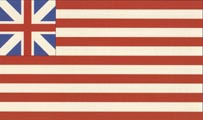
a blue field in the upper-left-hand corner bearing the red cross
of St. George of England with the white cross of St. Andrew of
Scotland. The "colonies" sought to govern themselves
or at least have a greater control of the local government and
still remain a participant in the United Kingdom. The purpose
was one of reconciliation of differences. The union of the flag
represented Great Britain and the 13 stripes represented the united
colonies in Northern America. <H-11>
RESOLVED: that the flag of the United States be thirteen
stripes, alternate red and white; that the Union be thirteen stars,
white in a blue field representing a new constellation.
.. Act of the Continental Congress, June 14, 1777.
2. American Revolution "Mullet"
(5 vs. 6 point) June 14, 1777: The British crosses were probably
dropped to 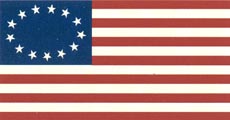 indicate
no hope of reconciliation under the Crown. Francis Hopkinson,
not Betsy Ross, probably made the first Stars & Stripes banner.
He was on the Naval Board and had a keen interest in heraldry.
"The five-pointed star as a political symbol originated during
the American Revolution. In the Old World the icon that resembles
such a star was an insignificant emblem that British and French
heraldry labeled a "mullet." This symbol does not connote
a star of the heavens but is rather a schematic representation
of the rowel of a spur, which in heraldry adored the arms of the
third-born son in a noble family. The celestial star is the "estoile,"
with six wavy points, which by the seventeenth century had become
a common charge in heraldry. Before its incorporation into the
U. S. flag, the five-point star was rare on flags or other heraldic
devices." "Having little regard for Old World formalities,
colonial Americans opted to represent the heavenly star with five
points rather than the more proper six points of the estoile."
<H-11><M-20>
indicate
no hope of reconciliation under the Crown. Francis Hopkinson,
not Betsy Ross, probably made the first Stars & Stripes banner.
He was on the Naval Board and had a keen interest in heraldry.
"The five-pointed star as a political symbol originated during
the American Revolution. In the Old World the icon that resembles
such a star was an insignificant emblem that British and French
heraldry labeled a "mullet." This symbol does not connote
a star of the heavens but is rather a schematic representation
of the rowel of a spur, which in heraldry adored the arms of the
third-born son in a noble family. The celestial star is the "estoile,"
with six wavy points, which by the seventeenth century had become
a common charge in heraldry. Before its incorporation into the
U. S. flag, the five-point star was rare on flags or other heraldic
devices." "Having little regard for Old World formalities,
colonial Americans opted to represent the heavenly star with five
points rather than the more proper six points of the estoile."
<H-11><M-20>
3. National Flag, 1818:
The practice of adding a star and a stripe for each new state
after the original proved too  cumbersome
and in 1818 Congress reverted back to the original thirteen stripes
and added a star for each new state, on the July 4th following
admission. Until 1912 the arrangement of the stars was left to
the flag maker. <H-222>
cumbersome
and in 1818 Congress reverted back to the original thirteen stripes
and added a star for each new state, on the July 4th following
admission. Until 1912 the arrangement of the stars was left to
the flag maker. <H-222>
Mexican Flags of
Independence:
1. Virgin of Guadalupe,
1810: Father Miguel Hidalgo & Costilla, a priest who is credited
with beginning the Mexican  revolution
for independence on September 16, 1810 with his declaration called
the Grito de Delores. His followers rallied behind a simple church
banner with the Virgin of Guadalupe image. The image reminded
Father Hidalgo's followers of the important role their ancestors
had played in their country's history. [Angel with wings of green,
white and red was part of the image] Within a year the rally was
put down. <M-4>
revolution
for independence on September 16, 1810 with his declaration called
the Grito de Delores. His followers rallied behind a simple church
banner with the Virgin of Guadalupe image. The image reminded
Father Hidalgo's followers of the important role their ancestors
had played in their country's history. [Angel with wings of green,
white and red was part of the image] Within a year the rally was
put down. <M-4>
2. Flag of the Three Guarantees',
1821: Augustin de Iturbide negotiated the Plan de Iguala with
rebel Vincente 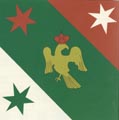 Guerrero
on February 24, 1821 for Mexico to become a "Constitutional
Monarchy." Iturbide offered a new flag that embodied the
tenets of the Three Guarantees (1. Primacy of the Catholic Church,
2. Independence and 3. Equality of Gachupines and native-born
Mexicans). The flag was designed by Jose Ocampo, a tailor. It
was a square flag with three diagonal bars of red, green &
white. This was changed in November 1821 to three vertical bars
rearranged to green, white & red. "A crowned eagle with
open wings perching on a cactus replaced the crown." Iturbide
was crowned emperor of Mexico on July 21, 1822 and shortly afterwards
disbanded the congress. <M-6>
Guerrero
on February 24, 1821 for Mexico to become a "Constitutional
Monarchy." Iturbide offered a new flag that embodied the
tenets of the Three Guarantees (1. Primacy of the Catholic Church,
2. Independence and 3. Equality of Gachupines and native-born
Mexicans). The flag was designed by Jose Ocampo, a tailor. It
was a square flag with three diagonal bars of red, green &
white. This was changed in November 1821 to three vertical bars
rearranged to green, white & red. "A crowned eagle with
open wings perching on a cactus replaced the crown." Iturbide
was crowned emperor of Mexico on July 21, 1822 and shortly afterwards
disbanded the congress. <M-6>
3. Mexican National Flag
April 1823: Antonio Lopez de Santa Anna led the revolt that overthrew
Iturbide early in 1823  (Plan
of Casa Mata) and Mexico became a Republic. "To represent
the republic, the imperial crown was removed from the eagle, and
the figure of a snake was added. As the traditional symbols of
strength and victory, branches of laurel and oak now wreathed
the base of the cactus." In 1916 the eagle symbol was changed
to the "Aztec Eagle" which is the image in use today.
<M-7, 8, 167n.20>
(Plan
of Casa Mata) and Mexico became a Republic. "To represent
the republic, the imperial crown was removed from the eagle, and
the figure of a snake was added. As the traditional symbols of
strength and victory, branches of laurel and oak now wreathed
the base of the cactus." In 1916 the eagle symbol was changed
to the "Aztec Eagle" which is the image in use today.
<M-7, 8, 167n.20>
Texas Flags of Independence:
I. Evolution of the "Lone
Star" symbol
1. West Florida Republic Flag,
September 26, 1810: "The Louisiana Purchase of 1803 had left
the territory of 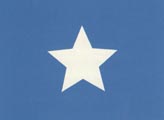 West
Florida - the area between the Pearl and the Mississippi Rivers
- in Spanish control." In September 1810, group of settlers
seized control, declared themselves a republic and offered themselves
for immediate annexation to the United States. President James
Madison obliged. "Thus, early nineteenth century Americans
adopted the five-point star as a symbol of 'enlightened revolution
against old-word monarchies - a moral crusade for the rights of
man'."<M-21>
West
Florida - the area between the Pearl and the Mississippi Rivers
- in Spanish control." In September 1810, group of settlers
seized control, declared themselves a republic and offered themselves
for immediate annexation to the United States. President James
Madison obliged. "Thus, early nineteenth century Americans
adopted the five-point star as a symbol of 'enlightened revolution
against old-word monarchies - a moral crusade for the rights of
man'."<M-21>
2. Long's Expedition Flag,
June 1818: The Adams-Onis Treaty of 1819 confirmed that Texas
was a part of Spanish 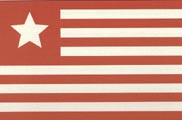 Mexico.
Some lower South citizens thought it belonged to the United States
and organized an army under the command of Dr. James Long. The
arrived in Nacogdoches and declared the province independent from
Spain with the intention of delivering it to the United States.
They flew a silk lone-star flag. The Spanish authorities quickly
drove the filibusters back across the Sabine. <M-21>
Mexico.
Some lower South citizens thought it belonged to the United States
and organized an army under the command of Dr. James Long. The
arrived in Nacogdoches and declared the province independent from
Spain with the intention of delivering it to the United States.
They flew a silk lone-star flag. The Spanish authorities quickly
drove the filibusters back across the Sabine. <M-21>
II. Mexican State Flags:
1. Coahuila y Tejas State Flag:
Based upon a militia flag from Nacogdoches required in 1828, it
is assumed that the  Mexican eagle adorned
the flag like the National Flag and the name of the state was
added at the top. <DP>
Mexican eagle adorned
the flag like the National Flag and the name of the state was
added at the top. <DP>
2.. Revised Coahuila y Texas
Flag (double star). Texas was a province affiliated with Coahuila
(a double state). Capital  was at
Saltillo until moved to Monclova on March 9, 1833. Flag made with
two stars in vertical position replacing the eagle motif. Coahuila
and Texas were joined as one state in 1825. Almonte said it was
flown at the Alamo when Santa Anna arrived. Also shown in a sketch
by Sanchez-Navarro during the siege. Assume the six pointed stars
were used since it was in the Mexican tradition. To use a five-pointed
star would indicate U. S. interests above Mexican. Some authors
show the five pointed star and it is known that the five pointed
star was used on private coinage in Bexar in 1818. <Veazy-6>
<A-162> <M-12> <DP>
was at
Saltillo until moved to Monclova on March 9, 1833. Flag made with
two stars in vertical position replacing the eagle motif. Coahuila
and Texas were joined as one state in 1825. Almonte said it was
flown at the Alamo when Santa Anna arrived. Also shown in a sketch
by Sanchez-Navarro during the siege. Assume the six pointed stars
were used since it was in the Mexican tradition. To use a five-pointed
star would indicate U. S. interests above Mexican. Some authors
show the five pointed star and it is known that the five pointed
star was used on private coinage in Bexar in 1818. <Veazy-6>
<A-162> <M-12> <DP>
In April, 1833 Texas suggested
its desire to become a separate state instead of a "double-state"
with Coahuila. Sam Houston chaired the committee that drafted
the sample state constitution. Stephen F. Austin took it to Mexico
City to present to the newly elected President Santa Anna. In
the meantime Santa Anna had turned running of the country over
to his vice-president Gomez Farias. Farias denied Austin's request.
Austin wrote a letter back to Texas saying they should begin setting
up a separate government even though he lacked the approval to
due such. Then Santa Anna returned and Austin again made his plea,
and although he was offered encouragement, the separation was
not forthcoming. In December 1833 Austin was on his way back to
Texas when he was arrested in Saltillo. The arrest was based upon
his earlier letter and Austin was returned to Mexico City and
put in jail. While Farias was acting President, his federalist
reforms were not popular with the Church and the military. Santa
Anna again returned in April 1834 and this time exiled Farias.
By October 1835 Santa Anna had reversed his political philosophy,
seized dictatorial powers and a centralist government replaced
the existing federalist form. Centralist were considered conservatives
since the favored the old Spanish form of government which combined
Church and State and favored the military. The Federalist were
the liberals as they believed in sharing power between the national
and the state governments and did not support favortism to the
Church and the military. <A-184, 185>
Some were for independence;
some for the constitution of 1824; and some for anything, just
so it was a row(e)….Noah
Smithwick
III. Battle Flags:
1. Scott's "Independence"
Flag, mid-Sept. 1835: The local committee of vigilance and
safety sent out a call to arms on about 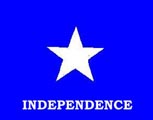 September
19, 1835 in response to news that Gen. Cos planned an invasion
of Texas. About 30 men responded to the call in Lynchburg and
were fully equipped by William Scott. He decided a flag should
be made. Charles Lanco, with the assistance of Mrs. Joseph Lynch
at Lynchburg made the flag (probably before Dodson's flag) . "Four
yards of blue silk donated by Scott with a painted white star
and the word "Independence." James L. McGahey took the
flag to the battle of Concepcion (Oct. 28th) (but had put in his
nap sack at San Felipe so it might not have flown), where he gave
it to Thomas B. Bell, who flew it at the Grass Fight (Nov. 26)
and perhaps in the (final stage of the) Siege of Bexar."
<M-24> <NHBTxOL-Flags><SWHQ:18-271>
September
19, 1835 in response to news that Gen. Cos planned an invasion
of Texas. About 30 men responded to the call in Lynchburg and
were fully equipped by William Scott. He decided a flag should
be made. Charles Lanco, with the assistance of Mrs. Joseph Lynch
at Lynchburg made the flag (probably before Dodson's flag) . "Four
yards of blue silk donated by Scott with a painted white star
and the word "Independence." James L. McGahey took the
flag to the battle of Concepcion (Oct. 28th) (but had put in his
nap sack at San Felipe so it might not have flown), where he gave
it to Thomas B. Bell, who flew it at the Grass Fight (Nov. 26)
and perhaps in the (final stage of the) Siege of Bexar."
<M-24> <NHBTxOL-Flags><SWHQ:18-271>
2. Dodson's "Lone Star"
flag, mid-Sept: 1835. Also responding to the September 19,
1835 call for volunteers, Capt.  Andrew
Robinson, Jr. raised a company from the community of Harrisburg
. Made by Sarah Dodson for her husband, Lt. Archelaus Bynum Dodson
for his volunteer company. Made of calico (cotton), blue, red
and white squares of equal sizes. "The white star allegedly
symbolized that Texas was the only Mexican state in which the
star of liberty was rising." Carried at least as far as Cibolo
Creek by James Ferguson and possibly at the Battle of Concepcion
and the Siege of Bexar. However, Austin had asked him not to fly
it at Bexar for fear that it would be considered a revolutionary
flag. Probably made after Scott's flag. At Washington on March
2 (Declaration of Independence), one of two flags. Considered
the first Tri-Color Lone Star flag. <V-7><NHBTxOL-Flags><
SWHQ:18-273, 274><M-24>
Andrew
Robinson, Jr. raised a company from the community of Harrisburg
. Made by Sarah Dodson for her husband, Lt. Archelaus Bynum Dodson
for his volunteer company. Made of calico (cotton), blue, red
and white squares of equal sizes. "The white star allegedly
symbolized that Texas was the only Mexican state in which the
star of liberty was rising." Carried at least as far as Cibolo
Creek by James Ferguson and possibly at the Battle of Concepcion
and the Siege of Bexar. However, Austin had asked him not to fly
it at Bexar for fear that it would be considered a revolutionary
flag. Probably made after Scott's flag. At Washington on March
2 (Declaration of Independence), one of two flags. Considered
the first Tri-Color Lone Star flag. <V-7><NHBTxOL-Flags><
SWHQ:18-273, 274><M-24>
3. Come & Take It,
Oct. 2, 1835: First flag of the revolution to see action. Designed
and painted by Cynthia Burns and  Evaline
DeWitt. Two descriptions (Smithwick: "white cotton cloth
about six fee long, in the center of which was painted in black
a picture of the old cannon, above it a lone star and beneath
it the words 'Come and Take it.'" Charles Mason: "a
white ground with a black cannon in the center, and the motto
'Come and take it!' above and below.") Left Gonzales on Oct.
13. Flag left along the road to Bexar with the broken cannon (carriage).
<SW-72><NHBTxOL-Flags> <M-23>
Evaline
DeWitt. Two descriptions (Smithwick: "white cotton cloth
about six fee long, in the center of which was painted in black
a picture of the old cannon, above it a lone star and beneath
it the words 'Come and Take it.'" Charles Mason: "a
white ground with a black cannon in the center, and the motto
'Come and take it!' above and below.") Left Gonzales on Oct.
13. Flag left along the road to Bexar with the broken cannon (carriage).
<SW-72><NHBTxOL-Flags> <M-23>
4. Dimmit's "Constitution
of 1824" flag, October 18, 1835: Made by Philip Dimmit,
commander of the fort at Goliad. On  October
27th he wrote Stephen F. Austin saying "I have had a flag
made - the colours, and their arrangement the same as the old
one - with the words and figures, 'Constitution of 24' displayed
on the white, in the center." This flag was an expression
of the "peace party" that desired a return to the Constitution
of 1824 which supported a federalist government and certain rights
to the states and their citizen. Santa Anna had suspended the
constitution when he declared himself dictator and returned to
the old Centralist form of government favored by the Church and
the military. On December 6th Dimmit took his flag to Bexar to
participate in the final assault. General Cos surrendered on Dec.
9th. The flag was left in Bexar since Dimmit changed his politics
about the struggle while in Bexar. The time for talk was over,
separation and independence was the only course of action. Grant
and Johnson, still seeking reconciliation, each lead a company
carrying an "1824" flag (don't know if "Constitution
of" was included) after leaving the Alamo and beginning on
the Matamoros Expedition. Meanwhile, Dimmit returned to Goliad
and designed another flag, this one for independence. <DP>
<Y>
October
27th he wrote Stephen F. Austin saying "I have had a flag
made - the colours, and their arrangement the same as the old
one - with the words and figures, 'Constitution of 24' displayed
on the white, in the center." This flag was an expression
of the "peace party" that desired a return to the Constitution
of 1824 which supported a federalist government and certain rights
to the states and their citizen. Santa Anna had suspended the
constitution when he declared himself dictator and returned to
the old Centralist form of government favored by the Church and
the military. On December 6th Dimmit took his flag to Bexar to
participate in the final assault. General Cos surrendered on Dec.
9th. The flag was left in Bexar since Dimmit changed his politics
about the struggle while in Bexar. The time for talk was over,
separation and independence was the only course of action. Grant
and Johnson, still seeking reconciliation, each lead a company
carrying an "1824" flag (don't know if "Constitution
of" was included) after leaving the Alamo and beginning on
the Matamoros Expedition. Meanwhile, Dimmit returned to Goliad
and designed another flag, this one for independence. <DP>
<Y>
5. New Orleans Grays, October:
Organized in New Orleans on October 13. Two companies were formed.
The first  under the command
of Capt. Thomas H. Breece and the second under Capt. Robert C.
Morris. They left New Orleans with in two days of each other,
bound for Texas. Breece took the northern route, overland route
and entered Texas over Gaines' Ferry. Morris and 68 men sailed
and arrived at Velasco on October 22nd. Breece's company was given
a flag "by a group of East Texas ladies." It is a blue
silk banner displaying an eagle and sunburst with the inscription
"First Company of Texan Volunteers! From New Orleans".
The eagle carries in its beak a banner with the motto "God
& Liberty." Breece took the flag to the Siege of Bexar,
arriving after Morris' company. After the fall of Bexar, all but
23 of the combined companies left with James Grant and F. W. Johnson
on the Matamoros Expedition but most then chose to stay with the
garrison at Goliad. The Grays flag was left at San Antonio with
the remaining Grays and all perished at the fall of the Alamo.
Santa Anna captured the flag and sent it as a trophy flag back
to Mexico after the fall of the Alamo. The only flag still in
existence that flew over the Alamo. Santa Anna reports that there
were more than one flag at the Alamo. <NHBTx: 2-1023> <NHBTxOL-Flags><NHBTx:
4-998><M-10, 27>
under the command
of Capt. Thomas H. Breece and the second under Capt. Robert C.
Morris. They left New Orleans with in two days of each other,
bound for Texas. Breece took the northern route, overland route
and entered Texas over Gaines' Ferry. Morris and 68 men sailed
and arrived at Velasco on October 22nd. Breece's company was given
a flag "by a group of East Texas ladies." It is a blue
silk banner displaying an eagle and sunburst with the inscription
"First Company of Texan Volunteers! From New Orleans".
The eagle carries in its beak a banner with the motto "God
& Liberty." Breece took the flag to the Siege of Bexar,
arriving after Morris' company. After the fall of Bexar, all but
23 of the combined companies left with James Grant and F. W. Johnson
on the Matamoros Expedition but most then chose to stay with the
garrison at Goliad. The Grays flag was left at San Antonio with
the remaining Grays and all perished at the fall of the Alamo.
Santa Anna captured the flag and sent it as a trophy flag back
to Mexico after the fall of the Alamo. The only flag still in
existence that flew over the Alamo. Santa Anna reports that there
were more than one flag at the Alamo. <NHBTx: 2-1023> <NHBTxOL-Flags><NHBTx:
4-998><M-10, 27>
6. Troutman "Lone Star"
flag, also known as the Ward's Georgia Battalion flag.
Late November: Johanna Troutman  made
the flag in November 1835 in Georgia. White silk displaying a
blue embroidered lone star and the words "Liberty or Death"
on one side and on the reverse the motto "Ubi Libertas Habitat,
Ibi Nostra Patria Est" (where liberty resides, there is our
homeland). Five-point star appliquéd on each side. Presented
to William Ward's Georgia Battalion. November 1835 (well after
the 12th) in Crawford County, Georgia. Carried to Texas and unfurled
at Velasco on January 8, 1836 (anniversary of the Battle of New
Orleans) over the American Hotel. Carried to Goliad where Fannin
raised it on March 8 at Goliad to celebrate the news of the Texas
Declaration of Independence. Destroyed by high winds at Goliad
that evening. Selected on Feb. 25, 1913 over Sara Dodson as "the
designer of the Lone Star flag of Texas" by both houses of
the Texas Legislature. <V-10> <NHBTxOL-Flags> <M-
><Vinson-113>
made
the flag in November 1835 in Georgia. White silk displaying a
blue embroidered lone star and the words "Liberty or Death"
on one side and on the reverse the motto "Ubi Libertas Habitat,
Ibi Nostra Patria Est" (where liberty resides, there is our
homeland). Five-point star appliquéd on each side. Presented
to William Ward's Georgia Battalion. November 1835 (well after
the 12th) in Crawford County, Georgia. Carried to Texas and unfurled
at Velasco on January 8, 1836 (anniversary of the Battle of New
Orleans) over the American Hotel. Carried to Goliad where Fannin
raised it on March 8 at Goliad to celebrate the news of the Texas
Declaration of Independence. Destroyed by high winds at Goliad
that evening. Selected on Feb. 25, 1913 over Sara Dodson as "the
designer of the Lone Star flag of Texas" by both houses of
the Texas Legislature. <V-10> <NHBTxOL-Flags> <M-
><Vinson-113>
7. Alabama's Red Rover flag,
late November: Company of 75 volunteers raised and equipped by
Dr. John Schackford  of Courtland,
Alabama, arrived in Jan. 1836. Called the Red Rovers because its
members were uniformed in red jeans. Small, square, red battle
flag reportedly captured at Goliad and taken to Mexico City. Most
were killed at Goliad. <Gilbert-64> <NHBTxOL-Flags>
of Courtland,
Alabama, arrived in Jan. 1836. Called the Red Rovers because its
members were uniformed in red jeans. Small, square, red battle
flag reportedly captured at Goliad and taken to Mexico City. Most
were killed at Goliad. <Gilbert-64> <NHBTxOL-Flags>
8. General Council's "1824"
privateer flag, Nov. 29, 1835. First official flag of the
Revolution. General Council  adopted
the "1824" flag which was a modification of Philip Dimmit's
flag of Oct. 27th. Using the Mexican National Flag, the tri-color
of green, white and red panels, the Mexican Eagle was replaced
with the numbers (representing the date of) 1824. The official
flag was approved for flying by privateers operating under Letters
of Marquee and Reprisal as late as Feb. 1836. Dr. Grant &
F. W. Johnson each flew a 1824 flag on their illfated Matamoros
Expedition. Popular myth holds that this flag flew at the Alamo
when it fell on March 6, 1836. It was neither captured or reported
in official journals. <Yates>
adopted
the "1824" flag which was a modification of Philip Dimmit's
flag of Oct. 27th. Using the Mexican National Flag, the tri-color
of green, white and red panels, the Mexican Eagle was replaced
with the numbers (representing the date of) 1824. The official
flag was approved for flying by privateers operating under Letters
of Marquee and Reprisal as late as Feb. 1836. Dr. Grant &
F. W. Johnson each flew a 1824 flag on their illfated Matamoros
Expedition. Popular myth holds that this flag flew at the Alamo
when it fell on March 6, 1836. It was neither captured or reported
in official journals. <Yates>
9. Dimmit's "Bloody Arm"
flag, Dec. 20, 1835: When Dimmit returned from the Siege of
Bexar where he flew his 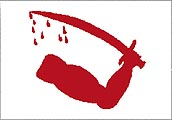 "Constitution
of 1824" flag, his politics had changed from the conservative
to the independence cause. Philip Dimmitt raised this new flag
at Goliad on Dec. 20, 1835, on the occasion of the Goliad Declaration
of Independence. Made of white cotton domestic two yards long,
one yard wide and in the center was painted with red ink or dye,
an arm and hand holding aloft a drawn sword. Dimmit remained as
commander of Goliad until removed Jan. 10 and the flag was taken
down. Dimmit was Alamo army storekeeper from Jan 24 to February
24. He arrived at San Jacinto with recruits and supplies on April
22nd. <NHBTxOL-Flags><NHBTx: 1-516> <DP>
"Constitution
of 1824" flag, his politics had changed from the conservative
to the independence cause. Philip Dimmitt raised this new flag
at Goliad on Dec. 20, 1835, on the occasion of the Goliad Declaration
of Independence. Made of white cotton domestic two yards long,
one yard wide and in the center was painted with red ink or dye,
an arm and hand holding aloft a drawn sword. Dimmit remained as
commander of Goliad until removed Jan. 10 and the flag was taken
down. Dimmit was Alamo army storekeeper from Jan 24 to February
24. He arrived at San Jacinto with recruits and supplies on April
22nd. <NHBTxOL-Flags><NHBTx: 1-516> <DP>
10. Sidney Sherman's "San
Jacinto" flag, late Dec. Brought to Texas by Sidney Sherman
organized a company of 52  volunteers
in Kentucky. Allegedly painted by James H. Beard and presented
to the Newport (Kentucky Rifle Company by Sherman's wife Katherine
Sherman. "The flag is made of white silk with the painted
figure of a partially bare-breasted woman grasping in one hand
a sword over which is draped a streamer with the words "Liberty
or Death". Probably based on Eugene Delacroix's painting
"Liberty Leading the People." The lady in the flag representing
liberty. Originally the (background) field was blue. The company
left Kentucky on Dec. 31 (but military service credited from Dec.
18). Not sure when they arrived in Texas. The only surviving flags
of the Texas Revolution are the Red Rover flag, the New Orleans
Greys flag and the San Jacinto flag. The former two are held in
Mexico as spoils of war and the San Jacinto flag is in Austin.
<NHBTxOL-Flags> <NHBTx:5-1020><M-26>
volunteers
in Kentucky. Allegedly painted by James H. Beard and presented
to the Newport (Kentucky Rifle Company by Sherman's wife Katherine
Sherman. "The flag is made of white silk with the painted
figure of a partially bare-breasted woman grasping in one hand
a sword over which is draped a streamer with the words "Liberty
or Death". Probably based on Eugene Delacroix's painting
"Liberty Leading the People." The lady in the flag representing
liberty. Originally the (background) field was blue. The company
left Kentucky on Dec. 31 (but military service credited from Dec.
18). Not sure when they arrived in Texas. The only surviving flags
of the Texas Revolution are the Red Rover flag, the New Orleans
Greys flag and the San Jacinto flag. The former two are held in
Mexico as spoils of war and the San Jacinto flag is in Austin.
<NHBTxOL-Flags> <NHBTx:5-1020><M-26>
11. Brown's "Bloody Arm"
flag, Flag created by William S. Brown of Velasco. Flown possibly
as early as Dec. 1835 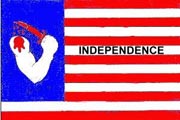 at the
Siege of Bexar by no collateral documentation. Flown at Velasco
on Jan. 8, 1836 at the American Hotel with the Troutman flag.
William S. Brown of Velasco. The flag consisted of thirteen alternating
red & white horizontal stripes and a blue union. The word
"Independence" was written on one white stripe (3rd
from the top, of six) and a sinewy arm and hand grasping a bloody
sword in the oversized (long) union.. One source says the flag
was flown at the Convention when Independence was declared on
March 2nd, along with the Dodson flag. However, Brown was made
captain of the schooner Liberty in January 1836, and continued
to serve until relieved of duty March 12. Do not know who would
have taken the flag to Washington. <V-9> <NHBTxOL-Flags>
at the
Siege of Bexar by no collateral documentation. Flown at Velasco
on Jan. 8, 1836 at the American Hotel with the Troutman flag.
William S. Brown of Velasco. The flag consisted of thirteen alternating
red & white horizontal stripes and a blue union. The word
"Independence" was written on one white stripe (3rd
from the top, of six) and a sinewy arm and hand grasping a bloody
sword in the oversized (long) union.. One source says the flag
was flown at the Convention when Independence was declared on
March 2nd, along with the Dodson flag. However, Brown was made
captain of the schooner Liberty in January 1836, and continued
to serve until relieved of duty March 12. Do not know who would
have taken the flag to Washington. <V-9> <NHBTxOL-Flags>
(Santa Anna's Alamo Red Flag:
Feb. 23, 1836) Santa Anna's Flag raised over the tower of San
Fernando de Bexar Church as a sign of no quarter. <NHBTxOL-Flags>
12. Baker's "San Felipe"
flag, Feb. 29, 1836. Flag presented Feb. 29, 1936 to the volunteer
company from San Felipe 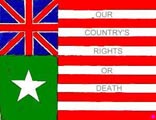 under
the leadership of Capt. Moseley Baker. Presented by Gail Borden,
Jr. Based upon the design of a flag by Stephen F. Austin described
in a letter to Borden. Thought to have been made by Pamela Shelpherd
and Nina Stewart in Shelpherd's house at San Felipe.. to Baker
at San Felipe on March 2. The English Jack designated the origin
of the Anglo-Americans; thirteen stripes represented that most
of the Texan Colonist were from the US, the tri-color of red,
white & green indicated that at one time Texas was a part
of the Mexican confederation and the white, five pointed star
stood for Texas herself - only state in Mexico claiming the light
of Liberty. Baker marched his men to Gonzales and joined Sam Houston's
army there. The San Felipe Volunteers remained a unit during the
retreat and participated, under Baker, at the Battle of San Jacinto
on April 21, 1836. Unfortunately the flag disappeared along the
way and Baker substituted a red handkerchief for his company's
flag at San Jacinto (see below). <dp> <NHBTxOL-Flags>
<Cox-178>
under
the leadership of Capt. Moseley Baker. Presented by Gail Borden,
Jr. Based upon the design of a flag by Stephen F. Austin described
in a letter to Borden. Thought to have been made by Pamela Shelpherd
and Nina Stewart in Shelpherd's house at San Felipe.. to Baker
at San Felipe on March 2. The English Jack designated the origin
of the Anglo-Americans; thirteen stripes represented that most
of the Texan Colonist were from the US, the tri-color of red,
white & green indicated that at one time Texas was a part
of the Mexican confederation and the white, five pointed star
stood for Texas herself - only state in Mexico claiming the light
of Liberty. Baker marched his men to Gonzales and joined Sam Houston's
army there. The San Felipe Volunteers remained a unit during the
retreat and participated, under Baker, at the Battle of San Jacinto
on April 21, 1836. Unfortunately the flag disappeared along the
way and Baker substituted a red handkerchief for his company's
flag at San Jacinto (see below). <dp> <NHBTxOL-Flags>
<Cox-178>
13. National "Naval"
flag, April 9. A National flag for naval service adopted April
9, 1836 at Harrisburg as the Interim  government
was in retreat. Flown before San Jacinto. Made at the home of
Mrs. Jane Harris by the ladies of Harrisburg. It had a "union
blue, star central, thirteen stripes prolonged, alternate red
and white." Burnet felt that the Navy flag then in use (1824,
see above) was confusing and would be mistaken for a Mexican vessel,
so he had this flag designed to be clearly seen as not Mexican,
and in fact, deceptive in its confusion with the U. S. Flag at
a distance. <SWHQ:59-488>
government
was in retreat. Flown before San Jacinto. Made at the home of
Mrs. Jane Harris by the ladies of Harrisburg. It had a "union
blue, star central, thirteen stripes prolonged, alternate red
and white." Burnet felt that the Navy flag then in use (1824,
see above) was confusing and would be mistaken for a Mexican vessel,
so he had this flag designed to be clearly seen as not Mexican,
and in fact, deceptive in its confusion with the U. S. Flag at
a distance. <SWHQ:59-488>
14. Baker's "Red"
flag at San Jacinto, April 21: Carried at San Jacinto on April
21, 1836 by Baker's company  (obviously
lost the San Felipe flag, see above). It was a red handkerchief
. It was carried until the battle commenced and was dropped and
lost. <SWHQ:45-45>
(obviously
lost the San Felipe flag, see above). It was a red handkerchief
. It was carried until the battle commenced and was dropped and
lost. <SWHQ:45-45>
Flags at San Jacinto:
1. Sidney Sherman's "San
Jacinto" flag, late Dec. Brought to Texas by Sidney Sherman
organized a company of 52  volunteers
in Kentucky. Allegedly painted by James H. Beard and presented
to the Newport (Kentucky Rifle Company by Sherman's wife Katherine
Sherman. "The flag is made of white silk with the painted
figure of a partially bare-breasted woman grasping in one hand
a sword over which is draped a streamer with the words "Liberty
or Death". Probably based on Eugene Delacroix's painting
"Liberty Leading the People." The lady in the flag representing
liberty. Originally the (background) field was blue. The company
left Kentucky on Dec. 31 (but military service credited from Dec.
18). Not sure when they arrived in Texas. The only surviving flags
of the Texas Revolution are the Red Rover flag, the New Orleans
Greys flag and the San Jacinto flag. The former two are held in
Mexico as spoils of war and the San Jacinto flag is in Austin.
<NHBTxOL-Flags> <NHBTx:5-1020><M-26>
volunteers
in Kentucky. Allegedly painted by James H. Beard and presented
to the Newport (Kentucky Rifle Company by Sherman's wife Katherine
Sherman. "The flag is made of white silk with the painted
figure of a partially bare-breasted woman grasping in one hand
a sword over which is draped a streamer with the words "Liberty
or Death". Probably based on Eugene Delacroix's painting
"Liberty Leading the People." The lady in the flag representing
liberty. Originally the (background) field was blue. The company
left Kentucky on Dec. 31 (but military service credited from Dec.
18). Not sure when they arrived in Texas. The only surviving flags
of the Texas Revolution are the Red Rover flag, the New Orleans
Greys flag and the San Jacinto flag. The former two are held in
Mexico as spoils of war and the San Jacinto flag is in Austin.
<NHBTxOL-Flags> <NHBTx:5-1020><M-26>
2. Baker's "Red"
flag : Carried at San Jacinto on April 21, 1836 by Baker's
company (obviously lost the San Felipe  flag).
It was a red handkerchief . It was carried until the battle commenced
and was dropped and lost. <SWHQ:45-45>
flag).
It was a red handkerchief . It was carried until the battle commenced
and was dropped and lost. <SWHQ:45-45>
3. Permanent Guerrero Battalion:
Arrived with the Mexican General Cos on the morning of April 21.
58" on the hoist 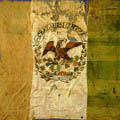 by 60"
on the fly. Located at the Texas State Archives.
by 60"
on the fly. Located at the Texas State Archives.
4. Permanent Matamoros Battalion:
Arrived at Bexar on February 23 with 272 veteran assault soldiers.
Participated in 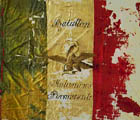 the Zacatecas
campaign the previous May. Marched with Santa Anna from Fort Bend.
Commander Col. Jose Maria Romero captured at San Jacinto. 57"
on the hoist by 67" on the fly. Located at the Texas State
Archives.
the Zacatecas
campaign the previous May. Marched with Santa Anna from Fort Bend.
Commander Col. Jose Maria Romero captured at San Jacinto. 57"
on the hoist by 67" on the fly. Located at the Texas State
Archives.
5. Active Toluca Battalion:
Arrived at Bexar on March 3rd with 324 veteran assault troops.
Participated in the 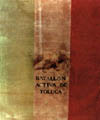 Zacatecas Campaign
in previous May. Suffered heavy casualties in the assault on the
Alamo. Only 130 survived. Arrived with General Cos in the morning
of April 21. 68" on the hoist by 54" on the fly. Currently
under restoration. On loan to the San Jacinto Museum.
Zacatecas Campaign
in previous May. Suffered heavy casualties in the assault on the
Alamo. Only 130 survived. Arrived with General Cos in the morning
of April 21. 68" on the hoist by 54" on the fly. Currently
under restoration. On loan to the San Jacinto Museum.
6. Santa Anna's "Guard"
flag. Carried by the 50 Escort Dragoons from the Permanent
Tampico Regiment and the 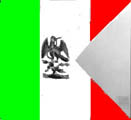 Guanajuato
Territorial Regiment. These Regiments participated previously
in the Goliad Campaign. Arrived with Santa Anna from Fort Bend.
Unknown dimensions. Color enhanced. Located at the Dallas Historical
Society.
Guanajuato
Territorial Regiment. These Regiments participated previously
in the Goliad Campaign. Arrived with Santa Anna from Fort Bend.
Unknown dimensions. Color enhanced. Located at the Dallas Historical
Society.
Flags of the Republic:
1. General Council's "1824"
naval flag, Nov. 29, 1835. First official flag of the Revolution.
General Council adopted  the "1824"
flag which was a modification of Philip Dimmit's flag of Oct.
27th. Using the Mexican National Flag, the tri-color of green,
white and red panels, the Mexican Eagle was replaced with the
numbers (representing the date of) 1824. The official flag was
approved for flying by privateers operating under Letters of Marquee
and Reprisal as late as Feb. 1836. Dr. Grant & F. W. Johnson
each flew a 1824 flag on their illfated Matamoros Expedition.
Popular myth holds that this flag flew at the Alamo when it fell
on March 6, 1836. It was neither captured or reported in official
journals. <Yates>
the "1824"
flag which was a modification of Philip Dimmit's flag of Oct.
27th. Using the Mexican National Flag, the tri-color of green,
white and red panels, the Mexican Eagle was replaced with the
numbers (representing the date of) 1824. The official flag was
approved for flying by privateers operating under Letters of Marquee
and Reprisal as late as Feb. 1836. Dr. Grant & F. W. Johnson
each flew a 1824 flag on their illfated Matamoros Expedition.
Popular myth holds that this flag flew at the Alamo when it fell
on March 6, 1836. It was neither captured or reported in official
journals. <Yates>
2. DeZavala's Flag, March
11, 1836, but no evidence it ever flown. DeZavala's Flag adopted
as the first Official  flag
of
flag
of 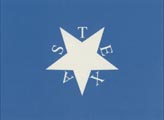 the Republic on March 11, 1836.
However, no evidence that it was ever flown. Amended by William
B. Scates on March 12 added a "rainbow and star of five points
above the western horizon; and the star of six points sinking
below." <SWHQ:59-487>
the Republic on March 11, 1836.
However, no evidence that it was ever flown. Amended by William
B. Scates on March 12 added a "rainbow and star of five points
above the western horizon; and the star of six points sinking
below." <SWHQ:59-487>
3. "National flag for
Naval Service", April 9, 1836. A National flag for naval
service adopted April 9, 1836 at  Harrisburg
as the Interim government was in retreat. Flown before San Jacinto.
Made at the home of Mrs. Jane Harris by the ladies of Harrisburg.
It had a "union blue, star central, thirteen stripes prolonged,
alternate red and white." Burnet felt that the Navy flag
then in use (1824, see above) was confusing and would be mistaken
for a Mexican vessel, so he had this flag designed to be clearly
seen as not Mexican, and in fact, deceptive in its confusion with
the U. S. Flag at a distance. <SWHQ:59-488>
Harrisburg
as the Interim government was in retreat. Flown before San Jacinto.
Made at the home of Mrs. Jane Harris by the ladies of Harrisburg.
It had a "union blue, star central, thirteen stripes prolonged,
alternate red and white." Burnet felt that the Navy flag
then in use (1824, see above) was confusing and would be mistaken
for a Mexican vessel, so he had this flag designed to be clearly
seen as not Mexican, and in fact, deceptive in its confusion with
the U. S. Flag at a distance. <SWHQ:59-488>
4. Burnet's flag, "National
Standard" Dec. 10, 1836. Burnet's Official flag December
10, 1836. "Azure ground, with 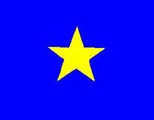 a
large golden star central." <SWHQ:59-489>
a
large golden star central." <SWHQ:59-489>
5. Stewart's "National
flag", Jan. 25, 1839: Dr. George B. Stewart's flag designated
official flag of the Republic on 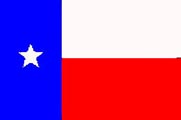 1839.
January 25, 1836 by act of congress as the national Standard.
Bill submitted by Senator Jones. Flag drawn by P. Krag, an artist,
and used as exhibit to the bill. <SWHQ:59-490> Subsequently
adopted as the State flag of Texas after it joined the Union.
<L-Art.6139a>
1839.
January 25, 1836 by act of congress as the national Standard.
Bill submitted by Senator Jones. Flag drawn by P. Krag, an artist,
and used as exhibit to the bill. <SWHQ:59-490> Subsequently
adopted as the State flag of Texas after it joined the Union.
<L-Art.6139a>
Flags at the time
of Statehood:
1. United States, 27 stars
 U. S. legislature approved annexation
of Texas on December 29, 1845. Texas joined the Union February
19, 1846 as the 28th state. The first U. S. flag had 27 stars
and the 28th star for Texas was added July 4, 1946. <Smithsonian
letter> When the state flag is displayed on a staff, the staff
should be at least 2 ½ times as long as the flag's hoist,
and the state flag should be attached to the staff's peak. The
staff's finial should be either a lone star or a spearhead. <L-Art.6139a>
U. S. legislature approved annexation
of Texas on December 29, 1845. Texas joined the Union February
19, 1846 as the 28th state. The first U. S. flag had 27 stars
and the 28th star for Texas was added July 4, 1946. <Smithsonian
letter> When the state flag is displayed on a staff, the staff
should be at least 2 ½ times as long as the flag's hoist,
and the state flag should be attached to the staff's peak. The
staff's finial should be either a lone star or a spearhead. <L-Art.6139a>
2. United States, 28 stars
a. version 1

Bibliography:
<A> Texas Almanac, 1986-87,
Dallas, Dallas Morning News, 1986
<C> Cox, Mamie Wynne, The
Romantic Flags of Texas, Dallas, Banks Upshaw & Company, 1936.
(T929.9 C 877, TX M, HPL)
<DP> Observations by David
Pomeroy
<H> Hinrichs, Kit &
Delphine, Long May She Wave, Berkeley, Ten Speed Press, (2002).
<L> Vernon's Texas Civil
Statutes
<M> Mayberry, Robert Jr,
Texas Flags, College Station, Texas A & M University Press,
2001.
<N> New Handbook of Texas
(generally)
<Q> Southwestern Historical
Quarterly (generally)
<S> E-mail from Smithsonian,
July 31, 1998, in author's possession.
<SW> Smithwick, Noah, Evolution of a State, Austin, University
of Texas Press, 1990
<V> Veazey, Steve &
Potter, John D. Jr. Flags in the History of Texas, Dallas, Hendrick-Long
Publishing Co., 1991
<Y> Yates, Charles
Return to Flag
Home Page
3.28.04
.

 indicate
no hope of reconciliation under the Crown. Francis Hopkinson,
not Betsy Ross, probably made the first Stars & Stripes banner.
He was on the Naval Board and had a keen interest in heraldry.
"The five-pointed star as a political symbol originated during
the American Revolution. In the Old World the icon that resembles
such a star was an insignificant emblem that British and French
heraldry labeled a "mullet." This symbol does not connote
a star of the heavens but is rather a schematic representation
of the rowel of a spur, which in heraldry adored the arms of the
third-born son in a noble family. The celestial star is the "estoile,"
with six wavy points, which by the seventeenth century had become
a common charge in heraldry. Before its incorporation into the
U. S. flag, the five-point star was rare on flags or other heraldic
devices." "Having little regard for Old World formalities,
colonial Americans opted to represent the heavenly star with five
points rather than the more proper six points of the estoile."
<H-11><M-20>
indicate
no hope of reconciliation under the Crown. Francis Hopkinson,
not Betsy Ross, probably made the first Stars & Stripes banner.
He was on the Naval Board and had a keen interest in heraldry.
"The five-pointed star as a political symbol originated during
the American Revolution. In the Old World the icon that resembles
such a star was an insignificant emblem that British and French
heraldry labeled a "mullet." This symbol does not connote
a star of the heavens but is rather a schematic representation
of the rowel of a spur, which in heraldry adored the arms of the
third-born son in a noble family. The celestial star is the "estoile,"
with six wavy points, which by the seventeenth century had become
a common charge in heraldry. Before its incorporation into the
U. S. flag, the five-point star was rare on flags or other heraldic
devices." "Having little regard for Old World formalities,
colonial Americans opted to represent the heavenly star with five
points rather than the more proper six points of the estoile."
<H-11><M-20> cumbersome
and in 1818 Congress reverted back to the original thirteen stripes
and added a star for each new state, on the July 4th following
admission. Until 1912 the arrangement of the stars was left to
the flag maker. <H-222>
cumbersome
and in 1818 Congress reverted back to the original thirteen stripes
and added a star for each new state, on the July 4th following
admission. Until 1912 the arrangement of the stars was left to
the flag maker. <H-222> revolution
for independence on September 16, 1810 with his declaration called
the Grito de Delores. His followers rallied behind a simple church
banner with the Virgin of Guadalupe image. The image reminded
Father Hidalgo's followers of the important role their ancestors
had played in their country's history. [Angel with wings of green,
white and red was part of the image] Within a year the rally was
put down. <M-4>
revolution
for independence on September 16, 1810 with his declaration called
the Grito de Delores. His followers rallied behind a simple church
banner with the Virgin of Guadalupe image. The image reminded
Father Hidalgo's followers of the important role their ancestors
had played in their country's history. [Angel with wings of green,
white and red was part of the image] Within a year the rally was
put down. <M-4> Guerrero
on February 24, 1821 for Mexico to become a "Constitutional
Monarchy." Iturbide offered a new flag that embodied the
tenets of the Three Guarantees (1. Primacy of the Catholic Church,
2. Independence and 3. Equality of Gachupines and native-born
Mexicans). The flag was designed by Jose Ocampo, a tailor. It
was a square flag with three diagonal bars of red, green &
white. This was changed in November 1821 to three vertical bars
rearranged to green, white & red. "A crowned eagle with
open wings perching on a cactus replaced the crown." Iturbide
was crowned emperor of Mexico on July 21, 1822 and shortly afterwards
disbanded the congress. <M-6>
Guerrero
on February 24, 1821 for Mexico to become a "Constitutional
Monarchy." Iturbide offered a new flag that embodied the
tenets of the Three Guarantees (1. Primacy of the Catholic Church,
2. Independence and 3. Equality of Gachupines and native-born
Mexicans). The flag was designed by Jose Ocampo, a tailor. It
was a square flag with three diagonal bars of red, green &
white. This was changed in November 1821 to three vertical bars
rearranged to green, white & red. "A crowned eagle with
open wings perching on a cactus replaced the crown." Iturbide
was crowned emperor of Mexico on July 21, 1822 and shortly afterwards
disbanded the congress. <M-6> (Plan
of Casa Mata) and Mexico became a Republic. "To represent
the republic, the imperial crown was removed from the eagle, and
the figure of a snake was added. As the traditional symbols of
strength and victory, branches of laurel and oak now wreathed
the base of the cactus." In 1916 the eagle symbol was changed
to the "Aztec Eagle" which is the image in use today.
<M-7, 8, 167n.20>
(Plan
of Casa Mata) and Mexico became a Republic. "To represent
the republic, the imperial crown was removed from the eagle, and
the figure of a snake was added. As the traditional symbols of
strength and victory, branches of laurel and oak now wreathed
the base of the cactus." In 1916 the eagle symbol was changed
to the "Aztec Eagle" which is the image in use today.
<M-7, 8, 167n.20> West
Florida - the area between the Pearl and the Mississippi Rivers
- in Spanish control." In September 1810, group of settlers
seized control, declared themselves a republic and offered themselves
for immediate annexation to the United States. President James
Madison obliged. "Thus, early nineteenth century Americans
adopted the five-point star as a symbol of 'enlightened revolution
against old-word monarchies - a moral crusade for the rights of
man'."<M-21>
West
Florida - the area between the Pearl and the Mississippi Rivers
- in Spanish control." In September 1810, group of settlers
seized control, declared themselves a republic and offered themselves
for immediate annexation to the United States. President James
Madison obliged. "Thus, early nineteenth century Americans
adopted the five-point star as a symbol of 'enlightened revolution
against old-word monarchies - a moral crusade for the rights of
man'."<M-21> Mexico.
Some lower South citizens thought it belonged to the United States
and organized an army under the command of Dr. James Long. The
arrived in Nacogdoches and declared the province independent from
Spain with the intention of delivering it to the United States.
They flew a silk lone-star flag. The Spanish authorities quickly
drove the filibusters back across the Sabine. <M-21>
Mexico.
Some lower South citizens thought it belonged to the United States
and organized an army under the command of Dr. James Long. The
arrived in Nacogdoches and declared the province independent from
Spain with the intention of delivering it to the United States.
They flew a silk lone-star flag. The Spanish authorities quickly
drove the filibusters back across the Sabine. <M-21> Mexican eagle adorned
the flag like the National Flag and the name of the state was
added at the top. <DP>
Mexican eagle adorned
the flag like the National Flag and the name of the state was
added at the top. <DP> was at
Saltillo until moved to Monclova on March 9, 1833. Flag made with
two stars in vertical position replacing the eagle motif. Coahuila
and Texas were joined as one state in 1825. Almonte said it was
flown at the Alamo when Santa Anna arrived. Also shown in a sketch
by Sanchez-Navarro during the siege. Assume the six pointed stars
were used since it was in the Mexican tradition. To use a five-pointed
star would indicate U. S. interests above Mexican. Some authors
show the five pointed star and it is known that the five pointed
star was used on private coinage in Bexar in 1818. <Veazy-6>
<A-162> <M-12> <DP>
was at
Saltillo until moved to Monclova on March 9, 1833. Flag made with
two stars in vertical position replacing the eagle motif. Coahuila
and Texas were joined as one state in 1825. Almonte said it was
flown at the Alamo when Santa Anna arrived. Also shown in a sketch
by Sanchez-Navarro during the siege. Assume the six pointed stars
were used since it was in the Mexican tradition. To use a five-pointed
star would indicate U. S. interests above Mexican. Some authors
show the five pointed star and it is known that the five pointed
star was used on private coinage in Bexar in 1818. <Veazy-6>
<A-162> <M-12> <DP> September
19, 1835 in response to news that Gen. Cos planned an invasion
of Texas. About 30 men responded to the call in Lynchburg and
were fully equipped by William Scott. He decided a flag should
be made. Charles Lanco, with the assistance of Mrs. Joseph Lynch
at Lynchburg made the flag (probably before Dodson's flag) . "Four
yards of blue silk donated by Scott with a painted white star
and the word "Independence." James L. McGahey took the
flag to the battle of Concepcion (Oct. 28th) (but had put in his
nap sack at San Felipe so it might not have flown), where he gave
it to Thomas B. Bell, who flew it at the Grass Fight (Nov. 26)
and perhaps in the (final stage of the) Siege of Bexar."
<M-24> <NHBTxOL-Flags><SWHQ:18-271>
September
19, 1835 in response to news that Gen. Cos planned an invasion
of Texas. About 30 men responded to the call in Lynchburg and
were fully equipped by William Scott. He decided a flag should
be made. Charles Lanco, with the assistance of Mrs. Joseph Lynch
at Lynchburg made the flag (probably before Dodson's flag) . "Four
yards of blue silk donated by Scott with a painted white star
and the word "Independence." James L. McGahey took the
flag to the battle of Concepcion (Oct. 28th) (but had put in his
nap sack at San Felipe so it might not have flown), where he gave
it to Thomas B. Bell, who flew it at the Grass Fight (Nov. 26)
and perhaps in the (final stage of the) Siege of Bexar."
<M-24> <NHBTxOL-Flags><SWHQ:18-271> Andrew
Robinson, Jr. raised a company from the community of Harrisburg
. Made by Sarah Dodson for her husband, Lt. Archelaus Bynum Dodson
for his volunteer company. Made of calico (cotton), blue, red
and white squares of equal sizes. "The white star allegedly
symbolized that Texas was the only Mexican state in which the
star of liberty was rising." Carried at least as far as Cibolo
Creek by James Ferguson and possibly at the Battle of Concepcion
and the Siege of Bexar. However, Austin had asked him not to fly
it at Bexar for fear that it would be considered a revolutionary
flag. Probably made after Scott's flag. At Washington on March
2 (Declaration of Independence), one of two flags. Considered
the first Tri-Color Lone Star flag. <V-7><NHBTxOL-Flags><
SWHQ:18-273, 274><M-24>
Andrew
Robinson, Jr. raised a company from the community of Harrisburg
. Made by Sarah Dodson for her husband, Lt. Archelaus Bynum Dodson
for his volunteer company. Made of calico (cotton), blue, red
and white squares of equal sizes. "The white star allegedly
symbolized that Texas was the only Mexican state in which the
star of liberty was rising." Carried at least as far as Cibolo
Creek by James Ferguson and possibly at the Battle of Concepcion
and the Siege of Bexar. However, Austin had asked him not to fly
it at Bexar for fear that it would be considered a revolutionary
flag. Probably made after Scott's flag. At Washington on March
2 (Declaration of Independence), one of two flags. Considered
the first Tri-Color Lone Star flag. <V-7><NHBTxOL-Flags><
SWHQ:18-273, 274><M-24> Evaline
DeWitt. Two descriptions (Smithwick: "white cotton cloth
about six fee long, in the center of which was painted in black
a picture of the old cannon, above it a lone star and beneath
it the words 'Come and Take it.'" Charles Mason: "a
white ground with a black cannon in the center, and the motto
'Come and take it!' above and below.") Left Gonzales on Oct.
13. Flag left along the road to Bexar with the broken cannon (carriage).
<SW-72><NHBTxOL-Flags> <M-23>
Evaline
DeWitt. Two descriptions (Smithwick: "white cotton cloth
about six fee long, in the center of which was painted in black
a picture of the old cannon, above it a lone star and beneath
it the words 'Come and Take it.'" Charles Mason: "a
white ground with a black cannon in the center, and the motto
'Come and take it!' above and below.") Left Gonzales on Oct.
13. Flag left along the road to Bexar with the broken cannon (carriage).
<SW-72><NHBTxOL-Flags> <M-23> October
27th he wrote Stephen F. Austin saying "I have had a flag
made - the colours, and their arrangement the same as the old
one - with the words and figures, 'Constitution of 24' displayed
on the white, in the center." This flag was an expression
of the "peace party" that desired a return to the Constitution
of 1824 which supported a federalist government and certain rights
to the states and their citizen. Santa Anna had suspended the
constitution when he declared himself dictator and returned to
the old Centralist form of government favored by the Church and
the military. On December 6th Dimmit took his flag to Bexar to
participate in the final assault. General Cos surrendered on Dec.
9th. The flag was left in Bexar since Dimmit changed his politics
about the struggle while in Bexar. The time for talk was over,
separation and independence was the only course of action. Grant
and Johnson, still seeking reconciliation, each lead a company
carrying an "1824" flag (don't know if "Constitution
of" was included) after leaving the Alamo and beginning on
the Matamoros Expedition. Meanwhile, Dimmit returned to Goliad
and designed another flag, this one for independence. <DP>
<Y>
October
27th he wrote Stephen F. Austin saying "I have had a flag
made - the colours, and their arrangement the same as the old
one - with the words and figures, 'Constitution of 24' displayed
on the white, in the center." This flag was an expression
of the "peace party" that desired a return to the Constitution
of 1824 which supported a federalist government and certain rights
to the states and their citizen. Santa Anna had suspended the
constitution when he declared himself dictator and returned to
the old Centralist form of government favored by the Church and
the military. On December 6th Dimmit took his flag to Bexar to
participate in the final assault. General Cos surrendered on Dec.
9th. The flag was left in Bexar since Dimmit changed his politics
about the struggle while in Bexar. The time for talk was over,
separation and independence was the only course of action. Grant
and Johnson, still seeking reconciliation, each lead a company
carrying an "1824" flag (don't know if "Constitution
of" was included) after leaving the Alamo and beginning on
the Matamoros Expedition. Meanwhile, Dimmit returned to Goliad
and designed another flag, this one for independence. <DP>
<Y> under the command
of Capt. Thomas H. Breece and the second under Capt. Robert C.
Morris. They left New Orleans with in two days of each other,
bound for Texas. Breece took the northern route, overland route
and entered Texas over Gaines' Ferry. Morris and 68 men sailed
and arrived at Velasco on October 22nd. Breece's company was given
a flag "by a group of East Texas ladies." It is a blue
silk banner displaying an eagle and sunburst with the inscription
"First Company of Texan Volunteers! From New Orleans".
The eagle carries in its beak a banner with the motto "God
& Liberty." Breece took the flag to the Siege of Bexar,
arriving after Morris' company. After the fall of Bexar, all but
23 of the combined companies left with James Grant and F. W. Johnson
on the Matamoros Expedition but most then chose to stay with the
garrison at Goliad. The Grays flag was left at San Antonio with
the remaining Grays and all perished at the fall of the Alamo.
Santa Anna captured the flag and sent it as a trophy flag back
to Mexico after the fall of the Alamo. The only flag still in
existence that flew over the Alamo. Santa Anna reports that there
were more than one flag at the Alamo. <NHBTx: 2-1023> <NHBTxOL-Flags><NHBTx:
4-998><M-10, 27>
under the command
of Capt. Thomas H. Breece and the second under Capt. Robert C.
Morris. They left New Orleans with in two days of each other,
bound for Texas. Breece took the northern route, overland route
and entered Texas over Gaines' Ferry. Morris and 68 men sailed
and arrived at Velasco on October 22nd. Breece's company was given
a flag "by a group of East Texas ladies." It is a blue
silk banner displaying an eagle and sunburst with the inscription
"First Company of Texan Volunteers! From New Orleans".
The eagle carries in its beak a banner with the motto "God
& Liberty." Breece took the flag to the Siege of Bexar,
arriving after Morris' company. After the fall of Bexar, all but
23 of the combined companies left with James Grant and F. W. Johnson
on the Matamoros Expedition but most then chose to stay with the
garrison at Goliad. The Grays flag was left at San Antonio with
the remaining Grays and all perished at the fall of the Alamo.
Santa Anna captured the flag and sent it as a trophy flag back
to Mexico after the fall of the Alamo. The only flag still in
existence that flew over the Alamo. Santa Anna reports that there
were more than one flag at the Alamo. <NHBTx: 2-1023> <NHBTxOL-Flags><NHBTx:
4-998><M-10, 27> made
the flag in November 1835 in Georgia. White silk displaying a
blue embroidered lone star and the words "Liberty or Death"
on one side and on the reverse the motto "Ubi Libertas Habitat,
Ibi Nostra Patria Est" (where liberty resides, there is our
homeland). Five-point star appliquéd on each side. Presented
to William Ward's Georgia Battalion. November 1835 (well after
the 12th) in Crawford County, Georgia. Carried to Texas and unfurled
at Velasco on January 8, 1836 (anniversary of the Battle of New
Orleans) over the American Hotel. Carried to Goliad where Fannin
raised it on March 8 at Goliad to celebrate the news of the Texas
Declaration of Independence. Destroyed by high winds at Goliad
that evening. Selected on Feb. 25, 1913 over Sara Dodson as "the
designer of the Lone Star flag of Texas" by both houses of
the Texas Legislature. <V-10> <NHBTxOL-Flags> <M-
><Vinson-113>
made
the flag in November 1835 in Georgia. White silk displaying a
blue embroidered lone star and the words "Liberty or Death"
on one side and on the reverse the motto "Ubi Libertas Habitat,
Ibi Nostra Patria Est" (where liberty resides, there is our
homeland). Five-point star appliquéd on each side. Presented
to William Ward's Georgia Battalion. November 1835 (well after
the 12th) in Crawford County, Georgia. Carried to Texas and unfurled
at Velasco on January 8, 1836 (anniversary of the Battle of New
Orleans) over the American Hotel. Carried to Goliad where Fannin
raised it on March 8 at Goliad to celebrate the news of the Texas
Declaration of Independence. Destroyed by high winds at Goliad
that evening. Selected on Feb. 25, 1913 over Sara Dodson as "the
designer of the Lone Star flag of Texas" by both houses of
the Texas Legislature. <V-10> <NHBTxOL-Flags> <M-
><Vinson-113> of Courtland,
Alabama, arrived in Jan. 1836. Called the Red Rovers because its
members were uniformed in red jeans. Small, square, red battle
flag reportedly captured at Goliad and taken to Mexico City. Most
were killed at Goliad. <Gilbert-64> <NHBTxOL-Flags>
of Courtland,
Alabama, arrived in Jan. 1836. Called the Red Rovers because its
members were uniformed in red jeans. Small, square, red battle
flag reportedly captured at Goliad and taken to Mexico City. Most
were killed at Goliad. <Gilbert-64> <NHBTxOL-Flags> adopted
the "1824" flag which was a modification of Philip Dimmit's
flag of Oct. 27th. Using the Mexican National Flag, the tri-color
of green, white and red panels, the Mexican Eagle was replaced
with the numbers (representing the date of) 1824. The official
flag was approved for flying by privateers operating under Letters
of Marquee and Reprisal as late as Feb. 1836. Dr. Grant &
F. W. Johnson each flew a 1824 flag on their illfated Matamoros
Expedition. Popular myth holds that this flag flew at the Alamo
when it fell on March 6, 1836. It was neither captured or reported
in official journals. <Yates>
adopted
the "1824" flag which was a modification of Philip Dimmit's
flag of Oct. 27th. Using the Mexican National Flag, the tri-color
of green, white and red panels, the Mexican Eagle was replaced
with the numbers (representing the date of) 1824. The official
flag was approved for flying by privateers operating under Letters
of Marquee and Reprisal as late as Feb. 1836. Dr. Grant &
F. W. Johnson each flew a 1824 flag on their illfated Matamoros
Expedition. Popular myth holds that this flag flew at the Alamo
when it fell on March 6, 1836. It was neither captured or reported
in official journals. <Yates> "Constitution
of 1824" flag, his politics had changed from the conservative
to the independence cause. Philip Dimmitt raised this new flag
at Goliad on Dec. 20, 1835, on the occasion of the Goliad Declaration
of Independence. Made of white cotton domestic two yards long,
one yard wide and in the center was painted with red ink or dye,
an arm and hand holding aloft a drawn sword. Dimmit remained as
commander of Goliad until removed Jan. 10 and the flag was taken
down. Dimmit was Alamo army storekeeper from Jan 24 to February
24. He arrived at San Jacinto with recruits and supplies on April
22nd. <NHBTxOL-Flags><NHBTx: 1-516> <DP>
"Constitution
of 1824" flag, his politics had changed from the conservative
to the independence cause. Philip Dimmitt raised this new flag
at Goliad on Dec. 20, 1835, on the occasion of the Goliad Declaration
of Independence. Made of white cotton domestic two yards long,
one yard wide and in the center was painted with red ink or dye,
an arm and hand holding aloft a drawn sword. Dimmit remained as
commander of Goliad until removed Jan. 10 and the flag was taken
down. Dimmit was Alamo army storekeeper from Jan 24 to February
24. He arrived at San Jacinto with recruits and supplies on April
22nd. <NHBTxOL-Flags><NHBTx: 1-516> <DP> volunteers
in Kentucky. Allegedly painted by James H. Beard and presented
to the Newport (Kentucky Rifle Company by Sherman's wife Katherine
Sherman. "The flag is made of white silk with the painted
figure of a partially bare-breasted woman grasping in one hand
a sword over which is draped a streamer with the words "Liberty
or Death". Probably based on Eugene Delacroix's painting
"Liberty Leading the People." The lady in the flag representing
liberty. Originally the (background) field was blue. The company
left Kentucky on Dec. 31 (but military service credited from Dec.
18). Not sure when they arrived in Texas. The only surviving flags
of the Texas Revolution are the Red Rover flag, the New Orleans
Greys flag and the San Jacinto flag. The former two are held in
Mexico as spoils of war and the San Jacinto flag is in Austin.
<NHBTxOL-Flags> <NHBTx:5-1020><M-26>
volunteers
in Kentucky. Allegedly painted by James H. Beard and presented
to the Newport (Kentucky Rifle Company by Sherman's wife Katherine
Sherman. "The flag is made of white silk with the painted
figure of a partially bare-breasted woman grasping in one hand
a sword over which is draped a streamer with the words "Liberty
or Death". Probably based on Eugene Delacroix's painting
"Liberty Leading the People." The lady in the flag representing
liberty. Originally the (background) field was blue. The company
left Kentucky on Dec. 31 (but military service credited from Dec.
18). Not sure when they arrived in Texas. The only surviving flags
of the Texas Revolution are the Red Rover flag, the New Orleans
Greys flag and the San Jacinto flag. The former two are held in
Mexico as spoils of war and the San Jacinto flag is in Austin.
<NHBTxOL-Flags> <NHBTx:5-1020><M-26> at the
Siege of Bexar by no collateral documentation. Flown at Velasco
on Jan. 8, 1836 at the American Hotel with the Troutman flag.
William S. Brown of Velasco. The flag consisted of thirteen alternating
red & white horizontal stripes and a blue union. The word
"Independence" was written on one white stripe (3rd
from the top, of six) and a sinewy arm and hand grasping a bloody
sword in the oversized (long) union.. One source says the flag
was flown at the Convention when Independence was declared on
March 2nd, along with the Dodson flag. However, Brown was made
captain of the schooner Liberty in January 1836, and continued
to serve until relieved of duty March 12. Do not know who would
have taken the flag to Washington. <V-9> <NHBTxOL-Flags>
at the
Siege of Bexar by no collateral documentation. Flown at Velasco
on Jan. 8, 1836 at the American Hotel with the Troutman flag.
William S. Brown of Velasco. The flag consisted of thirteen alternating
red & white horizontal stripes and a blue union. The word
"Independence" was written on one white stripe (3rd
from the top, of six) and a sinewy arm and hand grasping a bloody
sword in the oversized (long) union.. One source says the flag
was flown at the Convention when Independence was declared on
March 2nd, along with the Dodson flag. However, Brown was made
captain of the schooner Liberty in January 1836, and continued
to serve until relieved of duty March 12. Do not know who would
have taken the flag to Washington. <V-9> <NHBTxOL-Flags> under
the leadership of Capt. Moseley Baker. Presented by Gail Borden,
Jr. Based upon the design of a flag by Stephen F. Austin described
in a letter to Borden. Thought to have been made by Pamela Shelpherd
and Nina Stewart in Shelpherd's house at San Felipe.. to Baker
at San Felipe on March 2. The English Jack designated the origin
of the Anglo-Americans; thirteen stripes represented that most
of the Texan Colonist were from the US, the tri-color of red,
white & green indicated that at one time Texas was a part
of the Mexican confederation and the white, five pointed star
stood for Texas herself - only state in Mexico claiming the light
of Liberty. Baker marched his men to Gonzales and joined Sam Houston's
army there. The San Felipe Volunteers remained a unit during the
retreat and participated, under Baker, at the Battle of San Jacinto
on April 21, 1836. Unfortunately the flag disappeared along the
way and Baker substituted a red handkerchief for his company's
flag at San Jacinto (see below). <dp> <NHBTxOL-Flags>
<Cox-178>
under
the leadership of Capt. Moseley Baker. Presented by Gail Borden,
Jr. Based upon the design of a flag by Stephen F. Austin described
in a letter to Borden. Thought to have been made by Pamela Shelpherd
and Nina Stewart in Shelpherd's house at San Felipe.. to Baker
at San Felipe on March 2. The English Jack designated the origin
of the Anglo-Americans; thirteen stripes represented that most
of the Texan Colonist were from the US, the tri-color of red,
white & green indicated that at one time Texas was a part
of the Mexican confederation and the white, five pointed star
stood for Texas herself - only state in Mexico claiming the light
of Liberty. Baker marched his men to Gonzales and joined Sam Houston's
army there. The San Felipe Volunteers remained a unit during the
retreat and participated, under Baker, at the Battle of San Jacinto
on April 21, 1836. Unfortunately the flag disappeared along the
way and Baker substituted a red handkerchief for his company's
flag at San Jacinto (see below). <dp> <NHBTxOL-Flags>
<Cox-178> government
was in retreat. Flown before San Jacinto. Made at the home of
Mrs. Jane Harris by the ladies of Harrisburg. It had a "union
blue, star central, thirteen stripes prolonged, alternate red
and white." Burnet felt that the Navy flag then in use (1824,
see above) was confusing and would be mistaken for a Mexican vessel,
so he had this flag designed to be clearly seen as not Mexican,
and in fact, deceptive in its confusion with the U. S. Flag at
a distance. <SWHQ:59-488>
government
was in retreat. Flown before San Jacinto. Made at the home of
Mrs. Jane Harris by the ladies of Harrisburg. It had a "union
blue, star central, thirteen stripes prolonged, alternate red
and white." Burnet felt that the Navy flag then in use (1824,
see above) was confusing and would be mistaken for a Mexican vessel,
so he had this flag designed to be clearly seen as not Mexican,
and in fact, deceptive in its confusion with the U. S. Flag at
a distance. <SWHQ:59-488> by 60"
on the fly. Located at the Texas State Archives.
by 60"
on the fly. Located at the Texas State Archives. the Zacatecas
campaign the previous May. Marched with Santa Anna from Fort Bend.
Commander Col. Jose Maria Romero captured at San Jacinto. 57"
on the hoist by 67" on the fly. Located at the Texas State
Archives.
the Zacatecas
campaign the previous May. Marched with Santa Anna from Fort Bend.
Commander Col. Jose Maria Romero captured at San Jacinto. 57"
on the hoist by 67" on the fly. Located at the Texas State
Archives. Zacatecas Campaign
in previous May. Suffered heavy casualties in the assault on the
Alamo. Only 130 survived. Arrived with General Cos in the morning
of April 21. 68" on the hoist by 54" on the fly. Currently
under restoration. On loan to the San Jacinto Museum.
Zacatecas Campaign
in previous May. Suffered heavy casualties in the assault on the
Alamo. Only 130 survived. Arrived with General Cos in the morning
of April 21. 68" on the hoist by 54" on the fly. Currently
under restoration. On loan to the San Jacinto Museum. Guanajuato
Territorial Regiment. These Regiments participated previously
in the Goliad Campaign. Arrived with Santa Anna from Fort Bend.
Unknown dimensions. Color enhanced. Located at the Dallas Historical
Society.
Guanajuato
Territorial Regiment. These Regiments participated previously
in the Goliad Campaign. Arrived with Santa Anna from Fort Bend.
Unknown dimensions. Color enhanced. Located at the Dallas Historical
Society. flag
of
flag
of  the Republic on March 11, 1836.
However, no evidence that it was ever flown. Amended by William
B. Scates on March 12 added a "rainbow and star of five points
above the western horizon; and the star of six points sinking
below." <SWHQ:59-487>
the Republic on March 11, 1836.
However, no evidence that it was ever flown. Amended by William
B. Scates on March 12 added a "rainbow and star of five points
above the western horizon; and the star of six points sinking
below." <SWHQ:59-487> a
large golden star central." <SWHQ:59-489>
a
large golden star central." <SWHQ:59-489> 1839.
January 25, 1836 by act of congress as the national Standard.
Bill submitted by Senator Jones. Flag drawn by P. Krag, an artist,
and used as exhibit to the bill. <SWHQ:59-490> Subsequently
adopted as the State flag of Texas after it joined the Union.
<L-Art.6139a>
1839.
January 25, 1836 by act of congress as the national Standard.
Bill submitted by Senator Jones. Flag drawn by P. Krag, an artist,
and used as exhibit to the bill. <SWHQ:59-490> Subsequently
adopted as the State flag of Texas after it joined the Union.
<L-Art.6139a> U. S. legislature approved annexation
of Texas on December 29, 1845. Texas joined the Union February
19, 1846 as the 28th state. The first U. S. flag had 27 stars
and the 28th star for Texas was added July 4, 1946. <Smithsonian
letter> When the state flag is displayed on a staff, the staff
should be at least 2 ½ times as long as the flag's hoist,
and the state flag should be attached to the staff's peak. The
staff's finial should be either a lone star or a spearhead. <L-Art.6139a>
U. S. legislature approved annexation
of Texas on December 29, 1845. Texas joined the Union February
19, 1846 as the 28th state. The first U. S. flag had 27 stars
and the 28th star for Texas was added July 4, 1946. <Smithsonian
letter> When the state flag is displayed on a staff, the staff
should be at least 2 ½ times as long as the flag's hoist,
and the state flag should be attached to the staff's peak. The
staff's finial should be either a lone star or a spearhead. <L-Art.6139a>